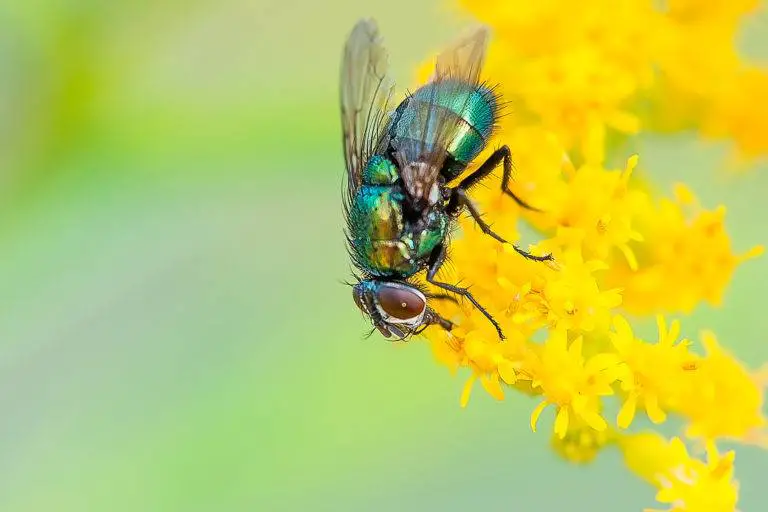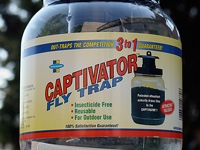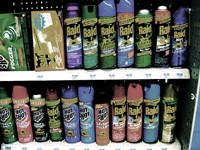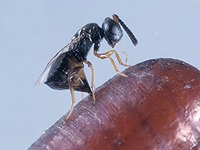
When I was a kid, I used to put flies into my Red Rider BB gun and shoot them at the window. Those flies that met their doom in this manner were house flies. The house fly (Musca domestica) has been buzzing around the world pestering animals for 65 million years, and humans for the last 50,000 or so. For the last couple million years, flies have made their home wherever people are. House flies aren’t biting flies; instead, they puke digestive juices on us and drink it up. The fact that they don’t bite doesn’t change the fact that they carry pathogens and thereby can cause disease. The house fly prefers to eat and lay its eggs in poop and other decaying organic matter. A female house fly can lay up to 500 eggs, in batches of 75–100 eggs each. The eggs hatch after a day. As larvae, the flies go through three stages of larval growth, known as instars. Note — young maggots are just fly larvae, so getting rid of flies is a great way to also get rid of maggots!
After a week of larval growth, the larvae climb to a cool, dry place and transform into pupae. Adult flies emerge from the pupae and live for 2–4 weeks. Flies depend upon warm weather to develop through metamorphosis; colder weather will slow their growth. During winter months, flies survive as larvae or pupae in a warm location. So…let’s kill ’em when they’re weak!
House Fly Diseases
Even though house flies don’t bite, they can still get you sick. Because house flies feed on excrement and garbage, they are known to carry disease-causing bacteria and viruses. These pathogens cause diarrhea, cholera, dysentery, food poisoning, yaws, and eye infections. These pathogens can be transferred to us when the flies feed on our food. That is why getting rid of house flies is so important.
Best Ways to Get Rid of House Flies

Controlling fly populations can be as simple as controlling its ability to feed and breed.
Flies eat decomposing organic matter, so don’t leave any laying around. Keep garbage in sealed bags inside of covered garbage cans. Store the garbage cans as far away from your home as possible. Other organic items, like animal poop, should not be allowed to pile up in your yard. If your garbage becomes infested with maggots, get rid of it right away. Spoiled food inside your home should be thrown away immediately. Chances are flies have already laid eggs in it, and maggots are on the way.
Keep flies out of your home by sealing up any entry points.
Flies are ridiculously small and therefore can find there way into your home through very small openings. Check for holes around windows and doors. Use a sealant like caulking to plug the holes. If there are holes in screens, patch or replace the screens. Check under your roof eaves for cracks, holes, or other entry points. Ventilation holes should be screened to keep flies out. Any point along the outside of your house where things, like wires and pipes, come in should be sealed as well.

Fly traps vary in size, style, and effectiveness.
Fly paper works well in small, confined areas for smaller populations of flies as long as no more flies are getting in. Another good indoor trap is an ultraviolet trap. Flies are attracted to the UV rays, and once inside, they get zapped. For outdoor applications, inverted cone fly traps work the best. Make sure to remove all competing sources of fly food, like garbage, poop, and what not. The traps should be placed about 30 feet apart. Common baits used for these traps include molasses, sugar, fruit, and meat. Commercial fly baits are usually made with a pheromone that attracts flies very well. You can check out Amazon’s vast selection of fly traps should you be so inclined.

Using insecticide spray should be reserved for when all other alternatives have been exhausted.
For the most part, the use of insecticides in your home will be unnecessary. Introducing toxic chemicals into your home is never a good idea. For those of you who are afflicted with plague-like swarms of flies every time you step outside, insecticides may be your only realistic alternative. This is more than likely going to be done by professionals. They will spray either permethrin or diclorvos on walls were flies congregate.

Augmentative biological control of house fly populations is an interesting technique.
The release of a parasitoid wasp is not exactly an option for most people. But the practice has grown popular on large farms where enormous piles of manure make ideal breeding grounds for fly populations. The wasp finds a fly while its in the pupal state and kills the pupa by stinging it. Then she lays a single egg into the shell. Once hatched the wasp larvae feeds on the dead fly pupa and grows. A few weeks later an adult wasp emerges. Adult wasps are effective at decreasing fly populations because they kill any fly pupa they come across, even if they don’t lay an egg inside.
Killing the House Fly
House flies are prolific breeders making it difficult to control an established population. But if you begin to cull their ability to feed and breed by removing food sources in combination with the implementation of fly traps, you will begin to see a drastic reduction in population after 3–4 weeks. To keep flies out of your home, inspect the exterior for possible entry points. Using a caulking or expanding foam, seal up any hole, no matter the size. For advanced cases of house fly infestation, the use of a residual insecticide applied by a professional exterminator may be the only realistic option. But remember that adding nasty toxic chemicals to the environment around your house may have other side effects. The last, and possibly most entertaining, approach to getting rid of house flies is the use of parasitoid wasps. Although I am not sure how you get your hands on these little buggers, I am sure you will need a permit or something. But what happens when you have an out-of-control population of little wasps? What do you do to get rid of them? Perhaps my next article will be how to get rid of parasitoid wasps! Needless to say, maybe the wasp option isn’t the best.
Best Natural Fly Killers
Carnivorous plants, like the Venus fly trap or the pitcher plant, are available to purchase at a number of retailers.
This approach to getting rid of house flies is more entertaining than realistic. At least that is my assumption. I could be wrong; maybe they can effectively control a population of flies. Try it and let me know.
Boric acid is a commonly used natural insecticide.
Powdered boric acid is placed in places where insects congregate. The powder sticks to the hairs on the insects body. When they preen themselves, they ingest the boric acid and die. Boric Acid powder from Amazon is reasonably priced.
The flyswatter is only as effective as the person doing the swatting.
Flies have a highly evolved evasive ability, which helps them to avoid getting whacked. It only takes a fly 200 milliseconds (.2 seconds) to respond to impending death. Try swatting with two objects from opposite directions to confuse them.